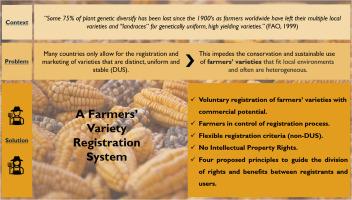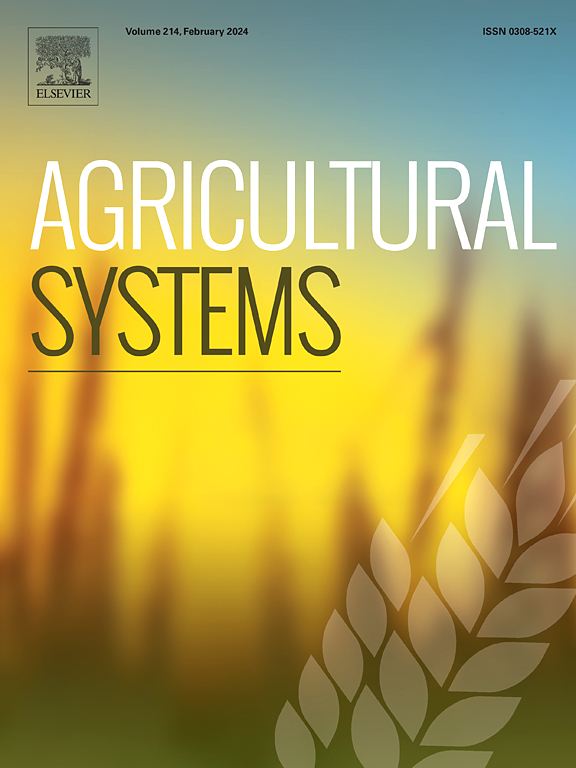Developing a registration system for farmers' varieties
IF 6.1
1区 农林科学
Q1 AGRICULTURE, MULTIDISCIPLINARY
引用次数: 0
Abstract
CONTEXT
Many countries only allow seed of registered varieties to be legally produced and sold in the market. Due to strict requirements regarding the characteristics (e.g., distinctness, uniformity, and stability) and performance (e.g., outperforming high-yielding varieties under standardized growing conditions) for varieties to be released, this implies that many farmers' varieties are confined to the spheres of the informal sector as ‘potential planting materials’: their production, use, exchange, and trade remain unregulated, largely unsupported, and their importance underestimated.
OBJECTIVE
The present article provides a guided approach on how to develop and implement a registration system suitable for farmers' varieties in full recognition of their inherent properties that often distinguish them from those that are developed in the formal seed sector.
METHOD
By following the seed regulatory value chain through which new crop varieties normally reach the market, this article analyses approaches to solve key questions that need to be addressed when adapting that regulatory chain to facilitate the registration and release of farmers' varieties. These questions range from what constitutes a farmers' variety to which rights a registrant may receive over the registered variety vis-à-vis other stakeholders. Answers are provided based on country cases, a literature review, and the learnings and inputs received during several stakeholder workshops and meetings organized in the context of seed system development programmes.
RESULTS AND CONCLUSIONS
Based on a discussion of the major principles and elements of current variety registration systems developed for the formal seed sector, our analysis leads to a plausible approach through which a farmers' variety registration system could be implemented. In that context, this study provides guidance on who qualifies to register a farmers' variety, how to agree on more flexible criteria for distinctness, uniformity, and stability, and elaborates key principles that can inform solutions for the division and distribution of rights, and access and benefit-sharing.
SIGNIFICANCE
Several national governments have indicated their interest in implementing a farmers' variety registration system. However, the practicalities on the ground and the principles that could guide implementation have not been elaborated or well-defined in the literature. This article aims to fill that gap. Through the registration and diffusion of farmers' varieties, governments will contribute to an increase of on-farm agro-biodiversity that can enhance farmers' resilience and livelihoods, while contributing to the implementation of Farmers' Rights as defined in the FAO International Treaty on Plant Genetic Resources for Food and Agriculture.

开发农民品种登记系统
康泰克TM 许多国家只允许合法生产和在市场上销售注册品种的种子。由于对品种的特性(如独特性、均匀性和稳定性)和性能(如在标准化种植条件下优于高产品种)有严格要求,这意味着许多农民的种子只能在市场上销售、这意味着许多农民的品种只能作为 "潜在的种植材料 "进入非正规部门的领域:它们的生产、使用、交换和贸易仍然不受监管,在很大程度上得不到支持,其重要性也被低估。通过跟踪作物新品种通常进入市场的种子监管价值链,本文分析了解决关键问题的方法,这些问题是在调整监管链以促进农民品种的注册和发布时需要解决的。这些问题包括什么是农民品种,以及相对于其他利益相关者,注册人对注册品种享有哪些权利。我们根据国家案例、文献综述以及在种子系统开发计划背景下组织的若干利益相关者研讨会和会议上获得的知识和意见,对这些问题进行了解答。在此背景下,本研究就以下方面提供了指导:谁有资格注册农民品种;如何商定更灵活的独特性、统一性和稳定性标准;并阐述了一些关键原则,这些原则可为权利的划分和分配以及获取和利益分享提供解决方案。然而,文献中并没有详细阐述或明确界定实地的实际情况以及可指导实施的原则。本文旨在填补这一空白。通过登记和推广农民品种,各国政府将有助于增加农场农业生物多样性,从而提高农民的抗灾能力和生计,同时有助于落实粮农组织《粮食和农业植物遗传资源国际条约》中规定的农民权利。
本文章由计算机程序翻译,如有差异,请以英文原文为准。
求助全文
约1分钟内获得全文
求助全文
来源期刊

Agricultural Systems
农林科学-农业综合
CiteScore
13.30
自引率
7.60%
发文量
174
审稿时长
30 days
期刊介绍:
Agricultural Systems is an international journal that deals with interactions - among the components of agricultural systems, among hierarchical levels of agricultural systems, between agricultural and other land use systems, and between agricultural systems and their natural, social and economic environments.
The scope includes the development and application of systems analysis methodologies in the following areas:
Systems approaches in the sustainable intensification of agriculture; pathways for sustainable intensification; crop-livestock integration; farm-level resource allocation; quantification of benefits and trade-offs at farm to landscape levels; integrative, participatory and dynamic modelling approaches for qualitative and quantitative assessments of agricultural systems and decision making;
The interactions between agricultural and non-agricultural landscapes; the multiple services of agricultural systems; food security and the environment;
Global change and adaptation science; transformational adaptations as driven by changes in climate, policy, values and attitudes influencing the design of farming systems;
Development and application of farming systems design tools and methods for impact, scenario and case study analysis; managing the complexities of dynamic agricultural systems; innovation systems and multi stakeholder arrangements that support or promote change and (or) inform policy decisions.
 求助内容:
求助内容: 应助结果提醒方式:
应助结果提醒方式:


